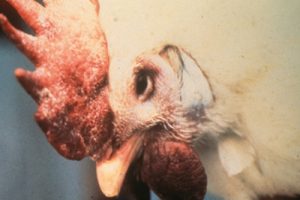Differences between avian influenza and pandemic human influenza
Differences between avian influenza and pandemic human influenza
A few avian influenza viruses have been shown to also infect humans, but these strains do not spread easily from birds to humans. Effectively all human infections have come from contact with infected birds and no significant transmission between humans has been confirmed.
Types of influenza viruses found in birds
All influenza viruses ever found in birds have been influenza “Type A” viruses. Many different subtypes and strains occur, which have variable

abilities to make birds ill. These subtypes are given names labelled with “H” and “N”, to reflect the genetic makeup of the virus and its ability to invade the birds’ cells. Some avian influenza viruses circulate naturally in wild birds, generally with little effect. When these viruses get into poultry (eg chickens, geese, quail), some are highly pathogenic and kill large numbers of birds.
Wild birds
Wild birds would not ordinarily present a threat to human health. The main threat to public health lies in a human “pandemic” of influenza that may have its origin in a bird. The virus will then be adapted to humans and unlikely to affect birds. Such an adaptation is highly unlikely to occur in Australia and would be brought here by the movement of humans rather than birds.
Human and Avian influenza viruses
- In humans, influenza viruses can be of type “A” or “B”.
- It is thought that all human influenza “A” viruses have originated from birds.
- Seasonal influenza epidemics occur every year and result from minor changes to the make-up of existing viruses. The changes are minor but substantial enough to create new strains of influenza that are still able to continue to spread from person to person. Vaccines are produced each year to protect people from seasonal influenza and is produced with knowledge of what the seasonal influenza virus is like.
- Health authorities generally believe that another pandemic is inevitable. The widespread nature and behaviour of H5N1 has set it as a likely candidate virus to change sufficiently to become a pandemic human virus. A pandemic arising from a different influenza virus is also possible.
- Purely on mathematical grounds, such a change from an avian to a human virus is likely to occur within those Asian countries with very large human populations that have regular contact with very large poultry populations. By comparison, Australia would be an extremely unlikely place to be the origin of such a pandemic.
- The possibility of change occurring in an intermediate species (like a pig) exists, especially if the pig were to be simultaneously infected with two influenza viruses.
- This change of virus need only occur once. It will then be spread onwards by a human to human transfer. It is likely that the virus will then no longer be capable of infecting birds.
The take home message is a human pandemic virus, if it were to arise, would come to Australia with a human and would not involve poultry.
Original author: Ron Glanville, QDPI&F

